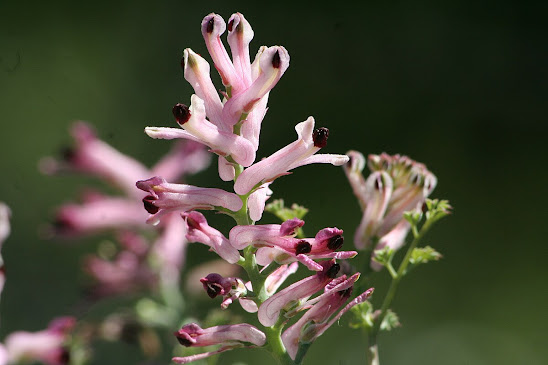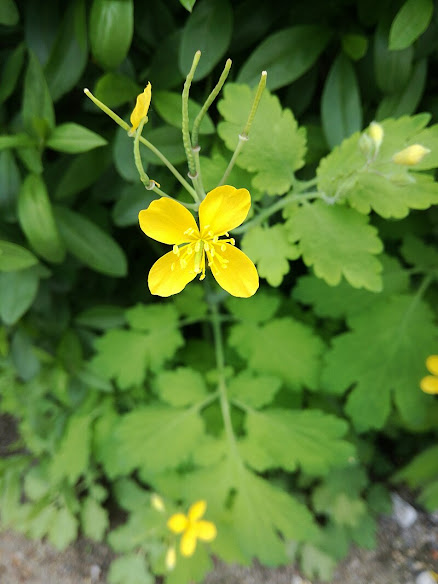Plant Indices
- Alphabetical Index (Genera)
- Alphabetical Index (Vernacular)
- Cladistic Index
BLEEDING HEART (Lamprocapnos)
Family: Papaveraceae
Species: Lamprocapnos spectabilis (syn. Dicentra spectabilis)

|
|
Bleeding Heart, 11th of May, 2008. Own work--Wuzur. |
Asia, East
- Cantonese: Hung Dau Lin, Yu Hung Fa
- Chinese: Chǎn Xiāng Sù, Hébāo Mǔdān, Yě Dié Xiān Cǎo
- Japanese: Ama No Dangō, Ki-Kikeman, Sintai-sou, Sumirehōzuki, Taitsurisō
- Korean: Cheonhaji, Geum Nang Hwa, Geumsimcho
- Mandarin: Fang Mai Hua, Hongdoulian, Yu Xin Cao, Yuhonghua
Asia, Southeast
- Indonesian: Kembang Hati
- Javanese: Kewaringin
Europe, Central
- Czech: Lýrovka, Srdcovka, Srdcovka Nádherná
- German: Berkendes Herz, Gebrochenes Herz, Herz-Tränendes Herz, Herzenblume, Spektakuläre Herzblume, Torstendes Herzen, Tränende Herzen, Tränendes Herz
- Hungarian: Szívvirág
- Polish: Bluszczyk, Dukatki, Serce, Serce Okazałe, Serduszka, Serduszka Okazała
- Slovak: Lýrovka Srdcovitá, Srdcovka Spectabilis
Europe, Northern
- Danish: Hjerteblomst, Jomfruhjerter, Løjtnantshjerte, Tørkepigekys, Trædendes Hjerte
- Finnish: Murtunut Sydän, Pikkusydän, Särkynyt Sydän
- Norwegian: Fløyelsblomst, Jomfru I Bad, Liemannshjerte
- Swedish: Hjärta, Hjärtblomma, Jungfru Maria's Hjärta
Europe, Southern
- Italian: Cuore Sanguinante
- Spanish: Corazón De María, Corazón Sangrante
Europe, Western
- Dutch: Dicentra, Ducat, Gebroken Hartje, Gebroken Hartjes, Vrouwenhart
- English: Bleeding Heart, Asian Bleeding Heart, Broken Heart, Dancing Ladies, Dutchman's Breeches, Dutchman's Trousers, Gold Bag Flower, Heart Flower, Lady In A Bath, Lady-in-the-bath, Lady's Locket, Locks And Keys, Lyre Flower, Old-fashioned Bleeding Heart, Our-Lady-in-a-Boat, Purse Peony, Showy Bleeding Heart, Venus's Car
- French: Coeur De Marie, Dicentra, Spectaculaire Dicentra
- Asia, East: China (Manchuria), Korea
This is the only species of the genus, a flowering plant that grows up to 120cm (47in) tall by 45cm (18in) wide. This plant has distinctive hanging flowers with a pair of large fuschia-pink petals that resemble a heart or some other vessel, and two inner petals that are white that, together, make a drop-like or vaguely human shape. The flowers bloom in spring, and may go dormant in the summer.
This plant loves shade and tends to grow in rock crevices at low altitudes.

|
|
Bleeding heart from a park in London, England, 19th of April, 2017. Photograph by Emőke Dénes. |
Good Fortune
The common Chinese name for this plant is hébāo mǔdān ("purse peony"). It is so named because the flowers resemble a hébāo, or "propitious pouch," a variety of traditional Chinese good luck charm. The "peony" in the name is because the plant's leaves resemble those of the tree peony (mǔdān/moutan). The symbolism is much the same in Korea, where it is called "gold bag flower" (geum nang hwa). In both China and Korea it is seen as an auspicious sign at New Years celebrations.
Jade Maiden Si Jun
The legend of Si Jun is the tale of a virtuous and faithful young woman fending off countless suitors and remaining true to her love, a young soldier. Si Jun's name means "thinks-of-her-lord," and she was modeled on the minor deity Yunü. Her secret lover was posted along the Great Wall for 2 years, unable to communicate with her, despite the many letters she sent him and gifts she sent. She relieved her yearning by embroidering purse charms and hanging them on the tree peony outside her window. She was so skilled at crafting these that the butterflies and bees were tricked and attempted to pollinate. The tree was soon covered with so many magnificent embroidered flowers that the tree seemed in full bloom despite being out of season. The immortals, in recognition of her patience and fidelity, transformed her tree peony into a brand-new plant, with blooms in imitation of her charms. For these reasons this flower is a quintessential love token, with the same romantic connotations as the [rose] does in Europe. Even today the offer of a bleeding heart in China may be interpreted by some as a proposal of marriage.
Japanese Symbolism
The Japanese name taitsurisō translates as "sea bream fishing rod," due to the resemblance of the flowers to small fish clasping even smaller fish in their jaws. Like with the purse identification in China and Korea, this fish-eating-fish imagery is an auspicious sign heavily associated with the New Years celebrations.
Victorian Flower Language
Per Greenaway, the bleeding heart indicates that one is putting their heart on their sleeve and can double as an invitation with the meaning "fly with me."

|
|
Close-up of a bleeding heart blossom upside-down, revealing the "lady-in-the-bath" From photographer's garden, 18th of May, 2013. Own work--Holger Casselmann. |
This plant has been cultivated for ornamental purposes for so long in Northeast Asia that it's basically impossible to determine its actual native range.
We are not a medical website, do not take health advice from us.
This plant has a history of use in traditional Chinese medicine. Its medicinal qualities under that system were identified as pungent, bitter, and warm. It was thought to restore jing to the liver.
Painkiller
This plant was taken as a painkiller.
Detox
The root was taken orally to detoxify the body.
Wounds and Sores
Was used topically to treat sores, bruises, and swellings, and eaten to treat mouth sores.
Circulation
Thought to improve circulation of blood.
GI Issues
Root taken orally to treat abdominal pain and flatulence.
Overdose is possible, causing tingling paresthesias on topical overdose, and oral consumption can cause vomiting, diarrhea, and in extreme cases respiratory failure and cardiac paralysis. Below these dangerous levels, the alkaloid protopine can cause confusion and irritability.
This plant resembles the Korean radish, and occasionally gets mistaken for such, resulting in poisonings.

|
|
Korean radish, 5th of Dec, 2011. Photo by Lee Sun-Deok, at blog.naver.com. |
- The plant's medicinal use as a painkiller might overlap with the notion of love as a balm to suffering. While this may be read as a positive, this could easily be employed as a reagent in manipulative charms.
- Paired with opium in a love charm, the target might become addicted to a false love and subject to serious withdrawal symptoms.
- Conflating the purse and fish-eating-fish interpretations and recasting them as malefic, the bleeding heart can be an emblem of greed or lust consuming innocence (the white figure in the middle).
- In a malevolent charm, the heart-devouring-woman read we just described could be used to turn the target's affection for another into a toxic obsession.
- The poison symptoms would also be great for manifestation of a toxic love charm: confusion, irritability, and finally paralysis of the heart.
- The lady-in-a-bath interpretation can be used for purification of the self. Might be employed in substitution of ritual purification requirements in a pinch.
- The bleeding heart might be used as an actual purse by a faerie character.
- Under the name "tree peony," it's worth exploring the relationship to [peony] and to tree.
- The name "Dutchman's Breeches" is obviously sexually suggestive. Further, the "pouch" and "purse" names may be references to testicles.
- The name "Lock and Key" also has an obvious sexual dimension. However, if we don't allow ourselves to get stuck on that, this flower enters the domain of security magic. It may be used as a reagent for locking and unlocking things, Consider its use for opening doors at a distance.
* * * * * * *
Prestigious Plants
- Plants
- Flowers
- Trees
- Ferns
- Moss and Lichen [Pending]
- Fungi [Pending]
- Cladistic Index
- Herbal Medicine [Pending]
- Resin, Incense, Balsam, and Lacquer [Pending]
Other Ranunculales
- Lardizabalaceae
- Chocolate Vine
- Dead Man's Fingers
- Papaveraceae
- Bleeding Heart
- Celandine
- Fumitory
- Poppy
- Ranunculaceae
- Adonis/Anemone/Pasque
- Buttercup/Crowfoot
- Clematis
- Columbine
- Coptis
- Hellebore
- Hepatica
- Larkspur
- Love in a Mist
- Monkshood/Wolfsbane
[Img 01 - https://en.wikipedia.org/wiki/File:Dicentra-spectabilis.jpg ]
[Img 02 - https://en.wikipedia.org/wiki/File:Ranunculales_-_Lamprocapnos_spectabilis_-_4.jpg ]
[Img 03 - https://en.wikipedia.org/wiki/File:Dicentra_spectabilis_HC2.JPG ]
[Img 04 - https://blog.naver.com/bizinfo1357/40146307080 ]























